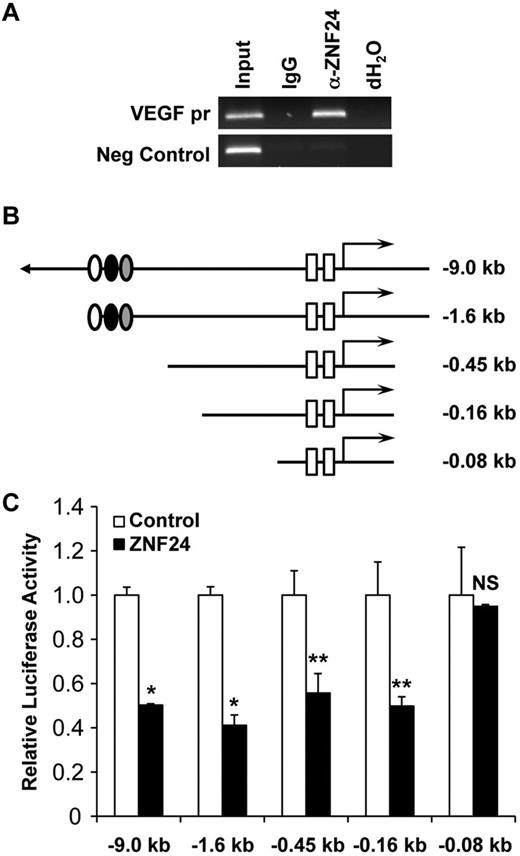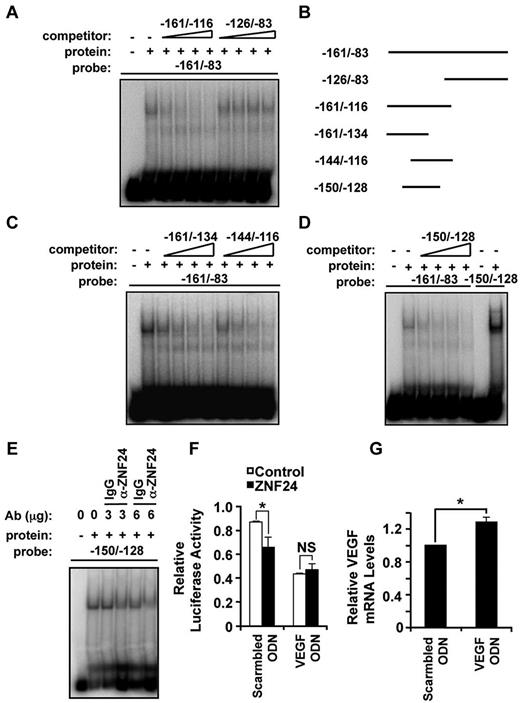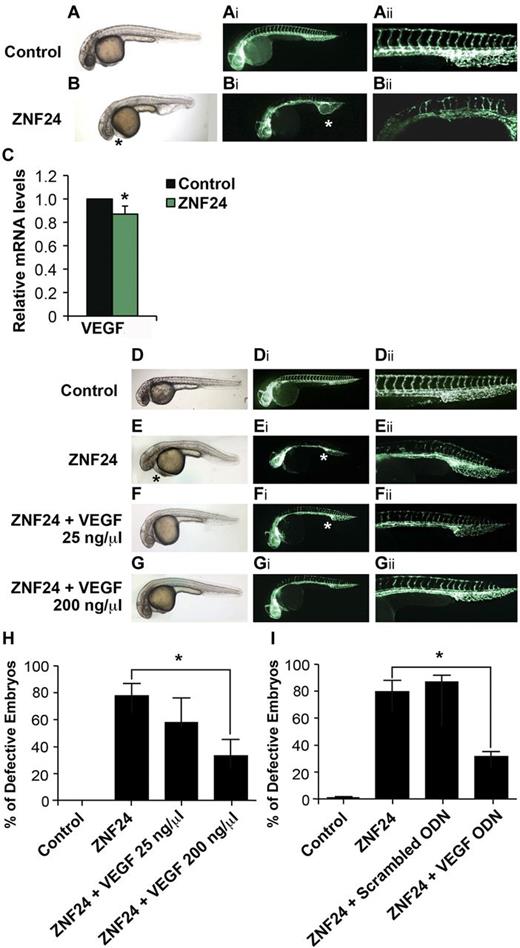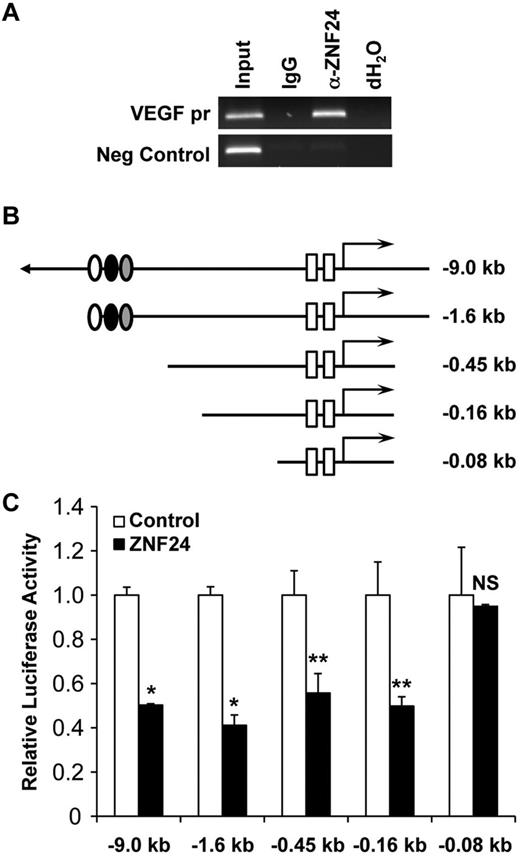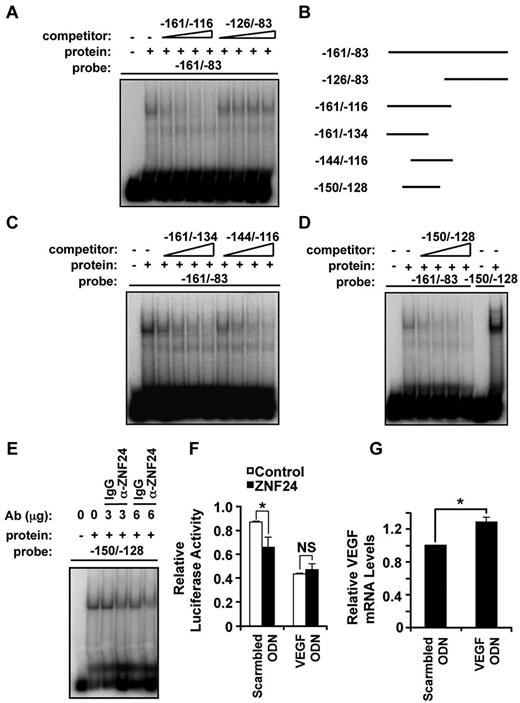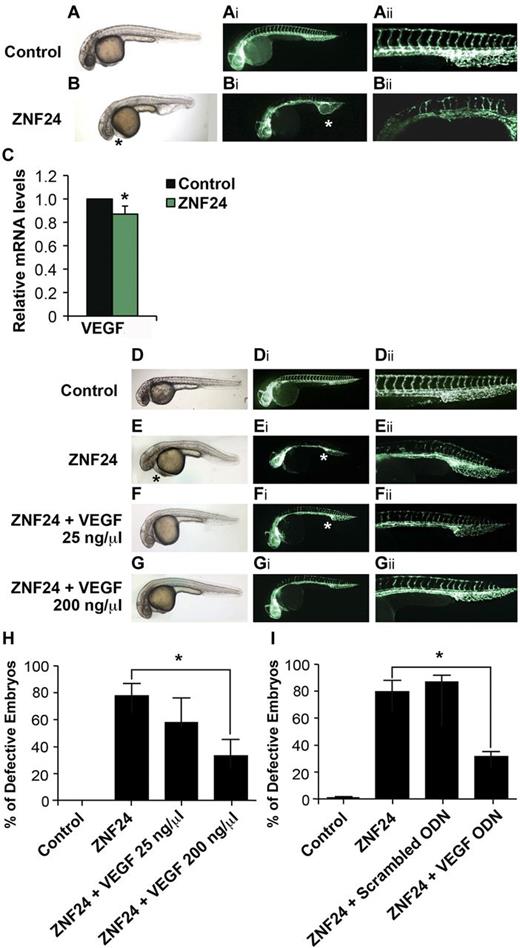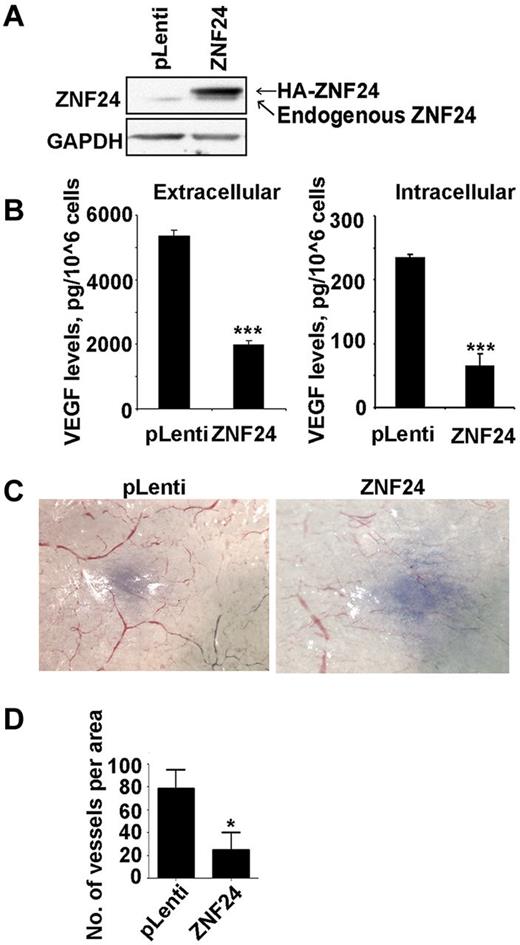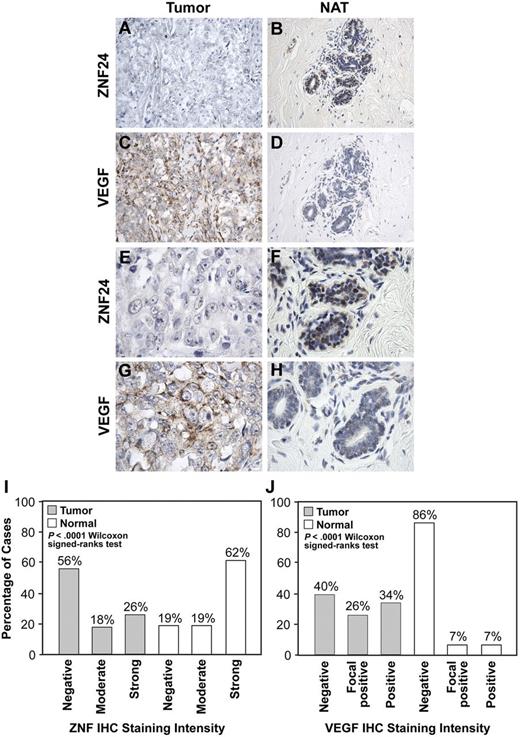Abstract
VEGF is a key regulator of normal and pathologic angiogenesis. Although many trans-activating factors of VEGF have been described, the transcriptional repression of VEGF remains much less understood. We have previously reported the identification of a SCAN domain–containing C2H2 zinc finger protein, ZNF24, that represses the transcription of VEGF. In the present study, we identify the mechanism by which ZNF24 represses VEGF transcription. Using reporter gene and electrophoretic mobility shift assays, we identify an 11-bp fragment of the proximal VEGF promoter as the ZNF24-binding site that is essential for ZNF24-mediated repression. We demonstrate in 2 in vivo models the potent inhibitory effect of ZNF24 on the vasculature. Expression of human ZNF24 induced in vivo vascular defects consistent with those induced by VEGF knockdown using a transgenic zebrafish model. These defects could be rescued by VEGF overexpression. Overexpression of ZNF24 in human breast cancer cells also inhibited tumor angiogenesis in an in vivo tumor model. Analyses of human breast cancer tissues showed that ZNF24 and VEGF levels were inversely correlated in malignant compared with normal tissues. These data demonstrate that ZNF24 represses VEGF transcription through direct binding to an 11-bp fragment of the VEGF proximal promoter and that it functions as a negative regulator of tumor growth by inhibiting angiogenesis.
Key Points
ZNF24 represses VEGF transcription through direct binding to an 11-bp fragment of the VEGF proximal promoter.
ZNF24 functions as a negative regulator of developmental and tumor angiogenesis by inhibiting VEGF transcription.
Introduction
VEGF is a key angiogenic factor during embryogenesis, as demonstrated by the embryonic lethality and abnormal blood vessel development of mice lacking a single VEGF allele.1 It also plays critical roles in normal physiologic processes such as maintaining vascular stability2 and promoting skeletal muscle differentiation.3 Across a wide range of human cancers, VEGF serves as a principle proangiogenic factor. For example, VEGF levels are elevated in breast cancer patients4 and are inversely correlated with patient survival.5 Transcriptional regulation of VEGF has been defined in part by its many transcriptional activators, including Sp1, HIF-1, and STAT3.6,7 In contrast, only the p53 family proteins and the von Hippel-Lindau (VHL) tumor suppressor have been discovered and well characterized as transcriptional repressors of VEGF.
Zinc finger protein 24 (ZNF24, also known as ZNF191 or Kox17) was originally identified in an attempt to discover novel C2H2 zinc finger proteins in the hematopoietic system.8 It possesses 4 Kruppel-like C2H2 zinc finger domains within the c-terminus that function as DNA-binding domains.9 These domains bind to the TCAT repeats of the HUMTH01 microsatellite located in the first intron of the tyrosine hydroxylase gene in in vitro studies.9,10 No in vivo function relevant to this observation has been documented to date. The N-terminus of ZNF24 contains a SCAN box domain that primarily serves as a dimerization domain for C2H2 zinc finger proteins, although its function in ZNF24 remains unknown. A function of ZNF24 in the regulation of angiogenesis has been implicated by its ability to repress the transcription of VEGF.11 The goal of the present study was to identify the mechanisms by which ZNF24 represses VEGF transcription and to determine the in vivo consequences of this repression. Our results showed that ZNF24 directly bound to the VEGF promoter to repress its transcription. We identified an 11-bp fragment of the proximal VEGF promoter that functions as the ZNF24-binding site and demonstrated the feasibility of using this fragment as a decoy to modulate endogenous VEGF levels. In vivo, we observed that the expression of ZNF24 in zebrafish embryos led to significantly decreased VEGF levels and induced vasculature defects consistent with those induced by VEGF knockdown. These defects could be rescued by overexpression of VEGF. Consistently, human breast cancer cells overexpressing ZNF24 exhibited significantly lower VEGF protein levels, resulting in their decreased ability to induce tumor angiogenesis. Human breast cancer tissues exhibited significantly decreased ZNF24 levels and significantly increased VEGF levels compared with normal adjacent tissues. In summary, our findings uncover the mechanism by which ZNF24 represses VEGF transcription and implicate ZNF24 as a potential inhibitor of angiogenesis in vivo.
Methods
Cell culture
MDA-MB-231 cells and MCF7 cells were cultured in low-glucose DMEM supplemented with 10% FBS (Life Technologies) and 1× penicillin-streptomycin glutamine (Life Technologies). M6C mouse breast cancer cells were a generous gift from Drs Silva Krause and Donald Ingber (Children's Hospital Boston and Harvard Medical School, Boston, MA) and were cultured in high-glucose DMEM supplemented with 10% FBS and 1× penicillin-streptomycin glutamine. Control MDA-MB-231 cells and cells overexpressing HA-ZNF24 were generated using the ViraPower Lentiviral Expression System (Life Technologies) and were cultured in low-glucose DMEM supplemented with 10% FBS, 1× penicillin-streptomycin glutamine, and 7 μg/mL of blasticidin according to the manufacturer's protocols.
Transfection and luciferase assays
VEGF promoter luciferase constructs, pIRES control construct, and pIRES-ZNF24 construct were generated as described previously.11,12 MDA-MB-231 cells were cotransfected with VEGF promoter–driven firefly luciferase constructs, the thymidine kinase promoter–driven Renilla luciferase construct, and with either the pIRES control construct or the pIRES-ZNF24 construct using Amaxa Biosystems Nucleofector (Lonza) according to the manufacturer's protocol. Forty-eight hours after transfection, cells were lysed and luciferase activity was determined using the Dual-Luciferase Reporter Assay System (Promega) according to the manufacturer's protocols.
EMSA
EMSAs were performed using nuclear extracts from HeLa cells overexpressing ZNF24 and 32P-labeled binding probes. For this assay, 3 μg of nuclear extracts was incubated with 1 ng of 32P-labeled probes in 20 μL of binding buffer (20mM Tris-HCl, pH 7.5, 100mM KCl, 0.1% NP-40, 2 μg of BSA, 2.5mM DTT, 5% glycerol, and 1 μg of poly(dI-dC) at room temperature for 20 minutes. The protein/DNA complexes were resolved on 5% polyacrylamide gel (Bio-Rad) and subjected to autoradiography. Unlabeled oligonucleotides at 10-, 25-, 50-, or 100-fold molar excess were used for competition experiments; 3 or 6 μg of α-ZNF24 (R&D Systems) or control IgG (Jackson ImmunoResearch Laboratories) was used for immunodepletion. The following oligonucleotides were used in EMSAs: −161/−83 VEGF promoter (5′-CCCTGGTAAGGGGTTTAGCTTTCCATTTCGCGGTAGTGGCCTAGGGGCTCCCCGAAAGGCGGTGCCTGGCTCCAC-CAG3′), −126/−83 VEGF promoter (5′-TAGTGGCCTAGGGGCTCC-CCGAAAGGCGGTGCCTGGCTCCACCAG-3′), −161/−116 VEGF promoter (5′-CCCTGGTAAGGGGTTTAGCTTTCCATTTCGCGGTAGTGGCCTAGG-3′), −161/−134 VEGF promoter (5′-CCCTGGTAA-GGGGTTTAGCTTTCCATTT-3′), −144/−116 VEGF promoter (5′-GCTTTCCATTTCGCGGTAGTGGCCTAGG-3′), −150/−128 VEGF promoter (5′-GGTTTAGCTTTCCATTTCGCGGT-3′), TCAT repeats (5′-TCATTCATTCAT TCATTCATTCATTCATTCATTCATTCAT-3′), and CCAC repeats (5′-CCACCCACCCACCCACCCACCCACCCACCCAC-CCACCCAC-3′).
ChIP assays
ChIP assays were performed using the ChIP-IT Express kit (Active Motif) according to manufacturer's protocols. Briefly, M6C cells were cultured on 150-mm plates to 70%-80% confluence and cross-linked using 1% formaldehyde. Chromatin was then harvested and sonicated 5 times on ice for 20 seconds each time. For chromatin immunoprecipitation, 200 μL of soluble sheared chromatin was incubated for 4 hours at 4°C with 50 μL of protein G magnetic beads and 5 μg of anti-ZNF24 (R&D Systems) or control Ab (Santa Cruz Biotechnology). Bound protein/DNA complexes were washed, reverse cross-linked, and digested with proteinase K. DNA was purified using a PCR Purification Kit (QIAGEN) and used for gene-specific PCR. The VEGF promoter region was amplified using primers 5′-GATAATTTTGAGGCCGTGGA-3′ and 5′-GGTAACAGCGGTGGAAGAAA-3′. The negative control region was amplified using primers 5′-ACAGGGGCTCCACTTAGACC-3′ and 5′-CCCTACAGTGCT-GTGGGTTT-3′.
ZNF24 decoy ODN treatment
The sequences of the forward strand for the oligodeoxynucleotides (ODNs) were as follows: VEGF ODN (5′-GGTTTAGCTTTCCATTTCGCGGT-3′) and scrambled ODN (5′-TTGCCGTACCTGACTTAGCC-3′). Double-stranded oligonucleotides were prepared by adding equal amounts of forward and reverse strand oligonucleotides in TE buffer (10mM Tris, pH 8.0, and 1mM EDTA), boiling for 5 minutes, and cooling slowly overnight at room temperature. For luciferase assays, MDA-MB-231 cells were transfected with plasmid constructs and ODNs using a 200-fold access of the ODN versus the VEGF promoter construct. For real-time RT-PCR, MCF7 cells were transfected with 1 μg of ODN using Lipofectamine RNAi Max Reagent (Life Technologies). RNA was isolated using the RNeasy Mini Kit (QIAGEN). Reverse transcription was performed using the iScript cDNA Synthesis Kit (Bio-Rad) and cDNAs were amplified using the following gene-specific primers: VEGF (5′-CAGAAGGAGGAGGGCAGAAT-3′ and 5′-CACACAGGATGGCTTGAAGA-3′) and GAPDH (5′-AGCCACATCGCTCAGACAC-3′ and 5′-AATGAAGGGGTCATTG-ATGG-3′).
ZNF24 expression in zebrafish embryos
All zebrafish and embryos were maintained at the Children's Hospital Boston aquatics facility in accordance with the housing and rearing procedures described by Westerfield et al.13 Human ZNF24 cDNA was cloned from pIRES-ZNF2411 into the pcDNA3.1 vector via HindIII and XhoI restriction sites. Capped mRNAs encoding ZNF24 and VEGF were generated using the Message Machine T7 kit according to the manufacturer's instructions (Life Technologies) and were injected into freshly fertilized transgenic Fli1:EGFP zebrafish embryos.14 Down-regulation of endogenous VEGF levels was achieved by injecting antisense oligonucleotides (5′-TAAGAAAGCGAAGCTGCTGGGTATG-3′; Genetools).15 Down-regulation of the zebrafish ZNF24 homolog gene expression was achieved by injecting antisense oligonucleotides (ENSDART00000124353: 5′-CGCTGTTTACTGCTAAAATTACACT-3′; Genetools). Phenotypes were observed at 30 hours postfertilization (hpf) for pericardial edema, abnormal formation of the caudal vascular plexus, and defects in intersegmental vessel (ISV) formation, and at 52 hpf for impaired circulation. For real-time RT-PCR, RNA was isolated using the RNeasy Mini Kit (QIAGEN) and reverse transcription was performed using the iScript cDNA Synthesis Kit (Bio-Rad). cDNAs were amplified using the following gene-specific primers: VEGF (5′-GTAATGATGAGGCGCTCGAA-3′ and 5′-TTTGGCCTGCATTCACACTT-3′); Elf1α (5′-CTTCTCAGGCTGACTGTGC-3′ and 5′-CCGCTAGCATTACCCTCC-3′)16 ; zebrafish ZNF24 homolog (5′-CAC-ATGGATGGTCACTCTGG-3′ and 5′-CATGTGAGCGCTGAGGTTTA-3′).
Immunoblot and ELISA assays
Protein extracts were prepared by lysing the cells using RIPA buffer (Santa Cruz Biotechnology) and were subjected to SDS-PAGE followed by immunoblotting. Primary Abs used were ZNF24 (R&D Systems) and GAPDH (EMD Millipore). ELISA assays were performed using the Human VEGF Quantikine ELISA Kit (R&D Systems).
In vivo angiogenesis assays
Control MDA-MB-231 cells and cells overexpressing ZNF24 were trypsinized and the cell suspension was mixed with trypan blue to facilitate visualization in vivo, as described previously.17 Fifty thousand cells were injected intradermally in 4 locations of the ventral surface of female nude mice. Six mice were injected for each cell line and the experiment was repeated twice. Three days after injection, mice were euthanized and skin flaps containing the tumor nodules were removed. The vessels surrounding and within the tumor nodules were counted under a dissecting microscope. The vessels within the same areas of uninjected skin were counted under the same magnification and subtracted from the number of vessels in tumor nodules. Procedures were performed in accordance with the institutional animal care and use committee of the University of Florida.
Immunohistochemistry
Immunohistochemistry was performed on paraffin-embedded human breast cancer tissue microarrays (TMAs; USBiomax) at the Dana-Farber/Harvard Cancer Center Research Pathology Core Facility using the standard protocol. Briefly, TMAs were deparaffinized and retrieved in citrate buffer, followed by incubation with primary Ab (α-ZNF24, R&D Systems; α-VEGF, Epitomics) for 1 hour and secondary Ab for 30 minutes. To quantify VEGF staining intensity, individual tissue cores in the TMAs were scored by a surgical pathologist (S.J.R.) as negative staining (0), focal positive staining (0.5), or positive staining (1). To assess ZNF24 nuclear staining, the stained TMAs were scanned using the Aperio ScanScope System and analyzed using Aperio ImageScope software (Version 10.0.36.1805, Aperio Technologies). A quantitative score of 0, 0.5, or 1 was assigned to each core on the TMAs based on raw optical density data which corresponded to negative staining (0), moderate staining (0.5) and strong staining (1) of the tumor cell nuclei as confirmed independently by the surgical pathologist. Microarray data are available at ArrayExpress (http://www.ebi.ac.uk/arrayexpress) under accession number E-MEXP-3775.
Statistical analysis
Values in all graphs represent means ± SD from 3 independent experiments unless otherwise stated in the figure legends. In general, unpaired 2-tailed Student t tests were used to compare mean differences in luciferase activities and mRNA levels between independent groups. Percentages of zebrafish embryos displaying specific phenotypes between groups were analyzed by the Pearson χ2 test. Staining intensity scores based on TMA data for ZNF24 and VEGF were compared between tumor and normal tissue with the nonparametric Wilcoxon signed-ranks test for matched pair data to assess differences in medians and distributions of 0, 0.5, and 1 scores. All P values are 2-tailed. Statistical analysis was performed using SPSS Version 18.0 software.
Results
Proximal VEGF promoter region is essential for ZNF24-mediated repression
The previous observation that ZNF24 repressed full-length VEGF promoter activity11 suggested that ZNF24 binds to the regulatory regions of the VEGF promoter to regulate its transcription. ChIP analysis was performed using mouse breast cancer cells (M6C) that constitutively express endogenous ZNF24 and demonstrated that ZNF24 specifically bound to the VEGF proximal promoter region (Figure 1A), indicating that VEGF is a direct transcriptional target of ZNF24. To determine the essential region of the VEGF promoter for ZNF24-mediated repression, we tested the ability of ZNF24 to repress the luciferase reporter gene driven by the full-length or truncated VEGF promoters (Figure 1B). ZNF24 was able to significantly repress the full-length, −1.6-kb, −0.45-kb, and −0.16-kb luciferase reporter genes, but not the −0.08-kb luciferase reporter gene (Figure 1C), leading to the conclusion that the necessary regulatory elements required for ZNF24-mediated repression lie within the −0.16-kb and −0.08-kb proximal promoter regions.
ZNF24 represses VEGF transcription by directly binding to its proximal promoter. (A) ChIP assays were performed using chromatin from M6C cells and the control IgG or the ZNF24 Ab. ChIP products were subjected to PCR using primers specific to VEGF promoter or a control genomic region. (B) Representation of the full-length and truncated VEGF promoter luciferase gene constructs. Ovals and boxes represent transcription factor-binding sites: Ap-1 (open oval), HIF-1 (filled oval), STAT-3 (shaded oval), and Sp1 (boxes). (C) Control plasmid or ZNF24 expression plasmid were cotransfected with indicated VEGF promoter luciferase constructs into MDA-MB-231 cells, and luciferase activities were quantified. Experiment was repeated in duplicate 3 times and 1 representative experiment is shown. *P ≤ .005; **P ≤ .05. NS indicates not significant.
ZNF24 represses VEGF transcription by directly binding to its proximal promoter. (A) ChIP assays were performed using chromatin from M6C cells and the control IgG or the ZNF24 Ab. ChIP products were subjected to PCR using primers specific to VEGF promoter or a control genomic region. (B) Representation of the full-length and truncated VEGF promoter luciferase gene constructs. Ovals and boxes represent transcription factor-binding sites: Ap-1 (open oval), HIF-1 (filled oval), STAT-3 (shaded oval), and Sp1 (boxes). (C) Control plasmid or ZNF24 expression plasmid were cotransfected with indicated VEGF promoter luciferase constructs into MDA-MB-231 cells, and luciferase activities were quantified. Experiment was repeated in duplicate 3 times and 1 representative experiment is shown. *P ≤ .005; **P ≤ .05. NS indicates not significant.
ZNF24 binds to an 11-bp region of the proximal VEGF promoter
ZNF24 is a member of the C2H2 zinc finger transcription factor family that binds to extremely diverse target DNA sequences.18 To date, no consensus DNA-binding sites for ZNF24 have been identified in vivo. EMSAs were performed to determine the ZNF24-binding site(s) on the proximal VEGF promoter. ZNF24 specifically bound to the −161/−83 promoter fragment (Figure 2A lanes 1-2 and supplemental Figure 1, available on the Blood Web site; see the Supplemental Materials link at the top of the online article). To further map the ZNF24-binding site, cold oligonucleotides representing different regions of the −161/−83 fragment were used as competitors in EMSA assays (Figure 2B). The −126/−83 cold oligonucleotide did not affect the association between ZNF24 and the −161/−83 fragment (Figure 2A lanes 7-10), whereas the −161/−116 cold oligonucleotide almost completely abolished the protein/DNA association (Figure 2A lanes 3-6), suggesting that the ZNF24-binding site lies within the −161/−116 region. Interestingly, both the −161/−134 and the −144/−116 cold oligonucleotides were able to compete with the −161/−83 probe to bind to ZNF24 (Figure 2C), leading to the hypothesis that the ZNF24-binding site resides within the overlapping 11-bp region of these 2 oligonucleotides, −144/−134. Next, a 23-bp fragment (−150/−128) was used to compete with the −161/−83 fragment in the binding reaction. This fragment contains the −144/−134 region as well as extra flanking nucleotides to facilitate the protein-DNA interaction. The −150/−128 fragment significantly reduced the binding between ZNF24 and the −161/−83 fragment in a dose-dependent manner (Figure 2D lanes 3-6). ZNF24 bound to the 150/−128 fragment specifically (Figure 2D lanes 7 and 8), because this binding was immunodepleted by the addition of the ZNF24 Ab but not control IgG (Figure 2E). These findings demonstrate that the 11-bp fragment (−144/−134) within the proximal VEGF promoter serves as ZNF24-binding site.
Identification of ZNF24-binding site within the proximal VEGF promoter. (A) EMSA assays were performed using the −161/−83 32P-labeled probe and indicated cold oligonucleotide competitors. (B) Representation of the 32P-labeled probes and cold oligonucleotide competitors used in EMSA assays. (C-D) EMSA assays were performed using the indicated 32P-labeled probes and cold oligonucleotide competitors. (E) The EMSA assay was performed using the −150/−128 fragment as the probe with the indicated Abs for immunodepletion. (F) Control plasmid or the ZNF24 expression plasmid was cotransfected with full-length VEGF promoter luciferase construct along with scrambled ODN or VEGF promoter ODN into MDA-MB-231 cells. *P = .04. NS indicates not significant. (G) The indicated ODNs were transfected into MCF7 cells and real-time PCR was performed using primers specific for VEGF and GAPDH. *P = 1.83 × 10−5.
Identification of ZNF24-binding site within the proximal VEGF promoter. (A) EMSA assays were performed using the −161/−83 32P-labeled probe and indicated cold oligonucleotide competitors. (B) Representation of the 32P-labeled probes and cold oligonucleotide competitors used in EMSA assays. (C-D) EMSA assays were performed using the indicated 32P-labeled probes and cold oligonucleotide competitors. (E) The EMSA assay was performed using the −150/−128 fragment as the probe with the indicated Abs for immunodepletion. (F) Control plasmid or the ZNF24 expression plasmid was cotransfected with full-length VEGF promoter luciferase construct along with scrambled ODN or VEGF promoter ODN into MDA-MB-231 cells. *P = .04. NS indicates not significant. (G) The indicated ODNs were transfected into MCF7 cells and real-time PCR was performed using primers specific for VEGF and GAPDH. *P = 1.83 × 10−5.
11-bp fragment of the VEGF promoter mediates VEGF transcription
Because of the ability of transcription factors to bind to their short DNA target sequences without the surrounding genomic DNA context, ODN decoys bearing the consensus binding sequence are often used to manipulate gene transcription in living cells by preventing the binding of transcription factors to their endogenous target sequences.19,20 Because our studies demonstrated that the 11-bp fragment of the proximal VEGF promoter serves as ZNF24-binding site, we next investigated whether the −150/−128 promoter region containing the 11-bp fragment could regulate VEGF expression in cells when used as ODN decoys for ZNF24. Cotransfection of the VEGF promoter ODN completely abolished the repression of the VEGF promoter by ZNF24, in contrast to the scrambled ODN, which did not affect the repression (Figure 2F). This result confirmed the fact that the 11-bp fragment represents the ZNF24-binding site on the VEGF promoter. Transfection of the VEGF ODN into MCF7 cells, which express high levels of endogenous ZNF24, significantly increased VEGF mRNA levels compared with the scrambled ODN (Figure 2G), demonstrating that the ODN decoy can regulate endogenous VEGF expression by interfering with the binding between the ZNF24 protein and the endogenous VEGF promoter.
Global expression of ZNF24 induces vascular defects in zebrafish embryos
Our data demonstrate that ZNF24 can repress VEGF transcription by binding directly to the proximal promoter region both in vitro and in vivo. The in vivo consequences of this repression was studied using the zebrafish model system, which permits the rapid examination of gene function during vascular development because of the optical clarity of the embryos and the availability of a transgenic line harboring an endothelial cell-specific fluorescent reporter (Fli1:EGFP).21 In zebrafish embryos, angiogenic sprouting occurs from the dorsal aorta as cells responding to the somatically expressed VEGF are stimulated to migrate dorsally along the boundaries of the somites and ultimately lumenize to form the ISVs.21-24 Capped mRNA encoding the full-length human ZNF24 was injected into freshly fertilized transgenic Fli1:EGFP zebrafish embryos and phenotypes were observed over the next 30 hpf. Compared with control embryos, ZNF24 expression resulted in several cardiovascular defects including pericardial edema (Figure 3A,B), abnormal formation of the caudal vascular plexus (Figure 3Ai,Bi), defects in ISV formation (Figure 3Aii,Bii and Table 1), and impaired circulation (Table 2). These defects are consistent with those induced by VEGF knockdown (supplemental Figure 2a-a” and Tables 1-2). Global expression of ZNF24 led to significantly decreased mRNA levels of VEGF (Figure 3C), suggesting that ZNF24 induces these defects by repressing VEGF transcription.
Expression of ZNF24 induces vascular defects in zebrafish embryos. Tg (Fli1:EGFP) embryos were injected with control (A-Aii) or ZNF24 mRNA (B-Bii, and images were taken at 30 hpf. (C) Embryos were injected with control or ZNF24 mRNA, and real-time PCR was performed using primers specific for VEGF and ELF1α. *P = .03. (D-Gii) Effects of ZNF24 expression can be rescued by overexpression of VEGF. Tg (Fli1:EGFP) embryos were injected with control (D-Dii), ZNF24 mRNA (E-Eii), ZNF24 mRNA and VEGF mRNA 25 ng/μL (F-Fii), or ZNF24 mRNA and VEGF mRNA 200 ng/μL (G-Gii), and images were taken at 30 hpf. Black asterisk indicates pericardial edema; white asterisk, abnormal caudal vascular plexus. (H) Percentages of defective embryos injected with indicated reagents. *P = .004 comparing embryos injected with ZNF24 mRNA alone and embryos injected with ZNF24 mRNA and VEGF mRNA 200 ng/μL. N indicates the number of experimental repeats; n the total number of embryos injected. Control: N = 3, n = 119; ZNF24: N = 3, n = 140; ZNF24 + VEGF 25 ng/μL: N = 3, n = 80; ZNF24 + VEGF 200 ng/μL: N = 3, n = 164. (I) Percentages of defective embryos injected with indicated reagents. *P = 8.09E-04 comparing embryos injected with ZNF24 mRNA alone and embryos injected with ZNF24 mRNA and VEGF promoter ODN. N indicates the number of experimental repeats; n the total number of embryos injected. Control: N = 3, n = 295; ZNF24: N = 3, n = 158; ZNF24 + Scrambled ODN: N = 3, n = 178; ZNF24 + VEGF ODN: N = 3, n = 147. Brightfield images were obtained at room temperature using a Nikon Eclipse 80i microscope equipped with a 4×/0.13 objective (Nikon), SPOT 7.4 Slider camera and SPOT software (Version 4.6, Diagnostic Instruments). Fluorescent images were obtained at room temperature using a Nicon Eclipse 80i microscope equipped with 4×/0.13 and 10×/0.30 objectives (Nikon), Retiga-2000R camera (QImaging), and NIS-Elements AR 3.0 software (Nikon).
Expression of ZNF24 induces vascular defects in zebrafish embryos. Tg (Fli1:EGFP) embryos were injected with control (A-Aii) or ZNF24 mRNA (B-Bii, and images were taken at 30 hpf. (C) Embryos were injected with control or ZNF24 mRNA, and real-time PCR was performed using primers specific for VEGF and ELF1α. *P = .03. (D-Gii) Effects of ZNF24 expression can be rescued by overexpression of VEGF. Tg (Fli1:EGFP) embryos were injected with control (D-Dii), ZNF24 mRNA (E-Eii), ZNF24 mRNA and VEGF mRNA 25 ng/μL (F-Fii), or ZNF24 mRNA and VEGF mRNA 200 ng/μL (G-Gii), and images were taken at 30 hpf. Black asterisk indicates pericardial edema; white asterisk, abnormal caudal vascular plexus. (H) Percentages of defective embryos injected with indicated reagents. *P = .004 comparing embryos injected with ZNF24 mRNA alone and embryos injected with ZNF24 mRNA and VEGF mRNA 200 ng/μL. N indicates the number of experimental repeats; n the total number of embryos injected. Control: N = 3, n = 119; ZNF24: N = 3, n = 140; ZNF24 + VEGF 25 ng/μL: N = 3, n = 80; ZNF24 + VEGF 200 ng/μL: N = 3, n = 164. (I) Percentages of defective embryos injected with indicated reagents. *P = 8.09E-04 comparing embryos injected with ZNF24 mRNA alone and embryos injected with ZNF24 mRNA and VEGF promoter ODN. N indicates the number of experimental repeats; n the total number of embryos injected. Control: N = 3, n = 295; ZNF24: N = 3, n = 158; ZNF24 + Scrambled ODN: N = 3, n = 178; ZNF24 + VEGF ODN: N = 3, n = 147. Brightfield images were obtained at room temperature using a Nikon Eclipse 80i microscope equipped with a 4×/0.13 objective (Nikon), SPOT 7.4 Slider camera and SPOT software (Version 4.6, Diagnostic Instruments). Fluorescent images were obtained at room temperature using a Nicon Eclipse 80i microscope equipped with 4×/0.13 and 10×/0.30 objectives (Nikon), Retiga-2000R camera (QImaging), and NIS-Elements AR 3.0 software (Nikon).
To determine whether the effects of ZNF24 expression on the developing zebrafish vasculature were VEGF specific, rescue experiments were conducted in which the ZNF24 mRNA was coinjected with mRNA encoding VEGF. Although control embryos showed no phenotypic changes in their vascular patterns (Figure 3D-Dii), 77% percent of embryos injected with ZNF24 mRNA exhibited ISV defects, venous plexus formation defects, or pericardial edema (Figure 3E-Eii,H). In contrast, when injected in combination with VEGF mRNA, the percentages of embryos exhibiting such defects were reduced in a dose-dependent fashion (Figure 3F-Gii,H). These results strongly suggest that ZNF24 expression alone results in pleiotropic effects on the forming vasculature by regulating VEGF levels.
To determine whether the regulation of VEGF levels by ZNF24 is through direct binding of the ZNF24 protein to the VEGF proximal promoter, scrambled ODN or VEGF promoter ODN representing the ZNF24-binding site were coinjected with ZNF24 mRNA. Although control embryos developed a normal vasculature (supplemental Figure 3a-a”), high percentages of embryos injected with ZNF24 mRNA alone or ZNF24 mRNA and scrambled ODN exhibited significant vascular defects (supplemental Figure 3b-c” and Figure 3I). In contrast, significantly lower percentages of embryos injected with ZNF24 mRNA and VEGF promoter ODN exhibited such defects (supplemental Figure 3d-d” and Figure 3I), suggesting that the VEGF promoter ODN rescues the ZNF24-induced vascular defects by binding to the ZNF24 protein and relieving its transcriptional repression of the endogenous VEGF gene. These results confirmed our findings in in vitro systems that ZNF24 represses VEGF transcription through binding to an 11-bp fragment within its proximal promoter.
ZNF24 is a zinc finger protein that contains 4 C2H2 zinc finger domains at the C-terminus and a SCAN domain at the N-terminus. Although SCAN domain–containing zinc finger proteins are unique to the mammalian proteome,25 the zinc finger domains of ZNF24 are conserved throughout evolution and have been shown to be sufficient to exert its other known functions in both mammalian and nonmammalian species.26 To further confirm the repression of VEGF transcription by ZNF24, morpholinos targeting the expression of zebrafish ZNF24 genes were injected into embryos and VEGF expression was analyzed by real-time PCR. Of the 4 morpholinos targeting 4 zebrafish genes that have the highest homology with human ZNF24, 1 resulted in a significant 2.1-fold increase in the level of VEGF (supplemental Figure 4a-b), suggesting that the target gene of this morpholino encodes a protein that functions as a negative regulator of zebrafish VEGF transcription and is likely a ZNF24 homolog in the zebrafish genome.
Overexpression of ZNF24 in human breast cancer cells inhibits tumor angiogenesis
To determine whether ZNF24 plays a similar inhibitory role during tumor angiogenesis, the human breast cancer cell line MDA-MB-231 was engineered to overexpress ZNF24 (Figure 4A). As expected, both extracellular and intracellular levels of VEGF were significantly decreased in cells overexpressing ZNF24 (Figure 4B). To determine the function of ZNF24 in tumor angiogenesis, control MDA-MB-231 cells and cells overexpressing ZNF24 were tested in an in vivo angiogenesis assay in which these cells were injected into the skin of nude mice, as described previously.17 Three days after injection, the blood vessels induced by tumor cells were counted. Cells overexpressing ZNF24 induced significantly lower numbers of blood vessels (Figure 4C-D), suggesting that ZNF24 plays an inhibitory role during tumor angiogenesis in vivo.
Overexpression of ZNF24 in human breast cancer cells leads to decreased VEGF levels and inhibition of tumor angiogenesis. (A) Protein extracts of control MDA-MB-231 cells and cells overexpressing ZNF24 were analyzed by immunoblot. (B) ELISA assays were performed using conditioned medium (left) and cell extracts (right) from control MDA-MB-231 cells or cells overexpressing ZNF24. ***P < .001. (C) In vivo angiogenesis assays were performed by injecting control MDA-MB-231 cells or cells overexpressing ZNF24. Images of tumor nodules were taken 3 days after injection. (D) Numbers of vessels induced by tumor nodules were quantified. pLenti: n = 23 tumor nodules; ZNF24: n = 17 tumor nodules. Data represent means ± SEM. *P < .05. Images were obtained at room temperature using a Leica MZ16F stereomicroscope equipped with a 4× objective with full-open aperature (Meyer Instruments), Retiga EXi camera (QImaging), and Openlab modular imaging software (PerkinElmer).
Overexpression of ZNF24 in human breast cancer cells leads to decreased VEGF levels and inhibition of tumor angiogenesis. (A) Protein extracts of control MDA-MB-231 cells and cells overexpressing ZNF24 were analyzed by immunoblot. (B) ELISA assays were performed using conditioned medium (left) and cell extracts (right) from control MDA-MB-231 cells or cells overexpressing ZNF24. ***P < .001. (C) In vivo angiogenesis assays were performed by injecting control MDA-MB-231 cells or cells overexpressing ZNF24. Images of tumor nodules were taken 3 days after injection. (D) Numbers of vessels induced by tumor nodules were quantified. pLenti: n = 23 tumor nodules; ZNF24: n = 17 tumor nodules. Data represent means ± SEM. *P < .05. Images were obtained at room temperature using a Leica MZ16F stereomicroscope equipped with a 4× objective with full-open aperature (Meyer Instruments), Retiga EXi camera (QImaging), and Openlab modular imaging software (PerkinElmer).
Levels of ZNF24 and VEGF are inversely correlated in human breast cancer and normal adjacent tissues
Given the profound inhibitory effect of ZNF24 in vivo, one would predict that ZNF24 would play a similar role in inhibiting angiogenesis during the initiation and progression of human cancers. Levels of ZNF24 and VEGF were analyzed in 68 cases of human breast cancer tissues, along with normal adjacent tissues (NATs) for each case. Representative images from serial sections of the tumor tissue and the NATs from the same patient stained with ZNF24 Ab or VEGF Ab are shown both at low magnification to demonstrate the staining intensities of the tissues (Figure 5A-D) and at high magnification to reveal the cellular localization of these 2 proteins (Figure 5E-H). In the normal epithelium, ZNF24 levels were high (Figure 5B), resulting in extremely low or undetectable VEGF levels in the same population of epithelial cells (Figure 5D). In contrast, in the tumor epithelium from the same patient, ZNF24 expression was absent (Figure 5A), with significantly increased VEGF levels in these cells (Figure 5C). Statistical analyses demonstrated that significantly lower and significantly higher percentages of tumor tissues exhibited strong ZNF24 staining and positive VEGF staining, respectively, compared with NATs (Figure 5I-J). When staining intensities were quantified, breast cancer tissues exhibited significantly lower levels of ZNF24 and significantly higher levels of VEGF compared with NATs (supplemental Figure 5). Combined with the findings by Thielemann et al27 in which increased VEGF levels and microvessel density were found in human breast cancer tissues, our results suggest that ZNF24 may play a negative role in the initiation and/or progression of human breast cancer by inhibiting tumor angiogenesis through regulation of VEGF expression.
ZNF24 levels and VEGF levels are inversely correlated in human breast cancer tissues compared with normal adjacent tissues. (A-H) Serial sections of human breast cancer TMAs containing malignant and normal adjacent tissues were stained with ZNF24 Ab (A,B,E,F) or VEGF Ab (C,D,G,H). Representative images of normal adjacent tissues and tumor tissues at 400× (A-D) and at 1000× (E-H) are shown. Histograms depict the percentages of patients demonstrating negative, moderate, or strong staining of ZNF24 (I) and negative, focal positive, or positive staining of VEGF (J). A higher percentage of negative ZNF24 staining was observed in tumors (median = negative staining) versus a higher percentage of positive staining in normal tissues (median = strong). A higher percentage of positive VEGF staining was observed in tumors (median = focal positive staining) versus a higher percentage of negative staining in normal tissues (median = negative staining). Images were obtained at room temperature using an Olympus BX41 microscope equipped with a 40×/0.75 objective and an 100×/1.30 oil-immersion objective (Olympus), Olympus Q-color5 digital camera (Olympus) and Adobe CS4 V.11 software (Adobe).
ZNF24 levels and VEGF levels are inversely correlated in human breast cancer tissues compared with normal adjacent tissues. (A-H) Serial sections of human breast cancer TMAs containing malignant and normal adjacent tissues were stained with ZNF24 Ab (A,B,E,F) or VEGF Ab (C,D,G,H). Representative images of normal adjacent tissues and tumor tissues at 400× (A-D) and at 1000× (E-H) are shown. Histograms depict the percentages of patients demonstrating negative, moderate, or strong staining of ZNF24 (I) and negative, focal positive, or positive staining of VEGF (J). A higher percentage of negative ZNF24 staining was observed in tumors (median = negative staining) versus a higher percentage of positive staining in normal tissues (median = strong). A higher percentage of positive VEGF staining was observed in tumors (median = focal positive staining) versus a higher percentage of negative staining in normal tissues (median = negative staining). Images were obtained at room temperature using an Olympus BX41 microscope equipped with a 40×/0.75 objective and an 100×/1.30 oil-immersion objective (Olympus), Olympus Q-color5 digital camera (Olympus) and Adobe CS4 V.11 software (Adobe).
Discussion
Induction of VEGF is tightly orchestrated by a concert of transcriptional activators, whereas little is known regarding its natural transcriptional repressors. Having previously discovered that ZNF24 represses the transcription of VEGF in multiple breast cancer cell lines,11 we now identify VEGF as a direct downstream target of ZNF24. Because of the lack of consensus DNA-binding sites for ZNF24, we combined reporter gene assays and EMSA assays to identify the ZNF24-binding site on the VEGF promoter. ZNF24 was found to bind to an 11-bp fragment of the proximal VEGF promoter (−144/−134), which was not previously known to interact with any transcriptional regulators of VEGF. The promoter region of the VEGF gene consists of numerous cis-regulatory elements that serve as docking sites for activating factors of VEGF such as Sp1,28 AP-2,29 and HIF-1.30 These factors function as mediators for signaling pathways regulating VEGF levels. In contrast, the few known transcriptional repressors of VEGF, namely VHL and the p53 family proteins, do not possess their own binding sites on the VEGF promoter. Instead, they modulate VEGF levels through activating factors such as HIF-131 and Sp1.32 The ZNF24-binding site on the VEGF promoter identified in the present study is the first consensus target DNA sequence for ZNF24-mediated transcriptional repression discovered to date and suggests a distinct mechanism of VEGF regulation by ZNF24.
When used as an ODN decoy, the 11-bp fragment induces VEGF expression by relieving VEGF repression by ZNF24. ODN technology has recently received considerable attention because of its ability to regulate transcription in a gene-specific manner by competing with endogenous DNA consensus sequences to bind to the transcription factor of interest. This technique can be used to inhibit target genes regulated by a transcriptional activator or to induce target genes regulated by a transcriptional repressor.33 Recent studies have shown that ODN decoys against NF-κB,19 Sp1,20 STAT,34 and E2F35 were able to modulate the transcription of their downstream target genes both in cell cultures and in animal models. Our studies using the ZNF24 decoy confirm the 11-bp fragment as the binding site for ZNF24 and raise the possibility of using this ODN decoy to regulate VEGF in vivo.
Because of the ability of ZNF24 to repress VEGF transcription in cultured cells,11 we investigated the function of ZNF24 during physiologic and pathologic angiogenesis in 3 in vivo models. Our results demonstrated that human ZNF24 expression disrupted the proper development and architecture of the zebrafish ISVs and induced other significant vascular defects such as pericardial edema and abnormal formation of caudal vascular plexus. In addition, expression of ZNF24 caused gross morphologic defects including improperly formed somites and decreases in head size and body length. These defects can be rescued by VEGF overexpression or by blocking the interaction between the ZNF24 protein and the VEGF promoter by the VEGF promoter ODN. Expression of ZNF24 led to significantly decreased VEGF levels, suggesting that ZNF24 inhibits angiogenesis by repressing VEGF. The transcriptional repression of VEGF by ZNF24 was further confirmed by knocking down the expression of the endogenous zebrafish ZNF24 gene, resulting in increased VEGF levels. Consistent with its functions during physiologic angiogenesis in the zebrafish model of blood vessel development, the overexpression of ZNF24 in human breast cancer cells significantly inhibited VEGF expression and decreased the angiogenic potential of these cells. Our findings demonstrate that ZNF24 plays an inhibitory role in normal vascular development and in tumor angiogenesis.
Increased VEGF levels have been shown in breast cancer patients both in the plasma36 and in the mammary epithelium,37 and at both the protein37 and mRNA4 levels. Our studies on human breast cancer tissues revealed a significant decrease in ZNF24 levels and a significant increase in VEGF levels in malignant tissues compared with normal tissues. The negative correlation between ZNF24 and VEGF levels suggested that ZNF24 might serve as a negative regulator of angiogenesis during tumor formation by repressing VEGF transcription. Interestingly, ZNF24 was identified as a gene exhibiting differential expression during the angiogenic switch.11 Combined with our observations from human breast cancer TMAs, ZNF24 may play a critical role in restricting VEGF levels both at the very early event of tumor initiation and at later stages of disease progression.
Our identification of the ZNF24-binding site on the VEGF promoter and observation of its gene-expression pattern in human breast cancer suggests the clinical potential of ZNF24 in the treatment of cancer and other disorders, adding to the armamentarium of angiogenesis regulators currently being studied.38,39 Given the versatile DNA-binding ability of C2H2 zinc finger proteins, researchers have fused the DNA-binding domains of these proteins with effector domains such as transcriptional activators and repressors,40 methylases,41 and nucleases42 to direct transcription or to modify genes. Similarly, the C2H2 DNA-binding domains of ZNF24 could be used as a homing device for the potent transcriptional activation or repression domains to the VEGF promoter, thereby facilitating their corresponding transcriptional regulation function. Furthermore, ZNF24 has been shown to regulate the transcription of other key regulators of tumor angiogenesis in addition to VEGF, such as PDGFRβ,43 suggesting a broader and more complicated function of ZNF24 than what is currently understood.
The online version of this article contains a data supplement.
The publication costs of this article were defrayed in part by page charge payment. Therefore, and solely to indicate this fact, this article is hereby marked “advertisement” in accordance with 18 USC section 1734.
Acknowledgments
The authors thank Drs Silva Krause and Donald Ingber for the generous gift of the M6C breast cancer cell line.
This work was supported by the National Institutes of Health (P01 CA045548), the Breast Cancer Research Foundation, the Fortin Foundation, and the Advanced Medical Research Foundation.
National Institutes of Health
Authorship
Contribution: D.J. and M.A.M. designed the experimental plan, including troubleshooting all experiments; D.J., S.M.H., J.C., D.F., L.R., and C.P. performed the experimental work; D.J., S.M.H., J.C., D.W.S., D.Z., S.J.R., and M.A.M. analyzed the data; P.A.D. provided new reagents; and D.J., S.M.H., and M.A.M. wrote the manuscript with input from the other authors.
Conflict-of-interest disclosure: The authors declare no competing financial interests.
Correspondence: Marsha A. Moses, PhD, Vascular Biology Program and Department of Surgery, Children's Hospital Boston and Harvard Medical School, Karp Family Research Building, 300 Longwood Ave, Boston, MA 02115; e-mail: marsha.moses@childrens.harvard.edu.

